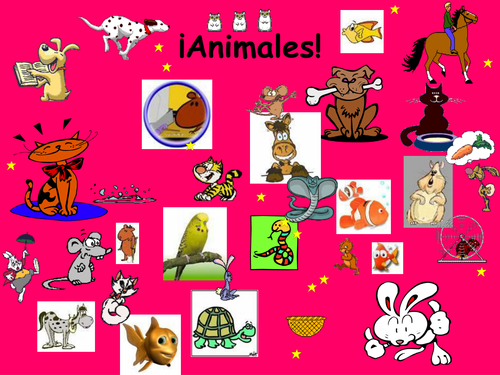

Spanish PowerPoint introducing pets / animals vocabulary:
Tengo un perro.
Tengo un gato.
Tengo un conejo.
Tengo un caballo.
Tengo un hámster.
Tengo un pájaro.
Tengo un ratón.
Tengo una serpiente.
Tengo una tortuga.
Tengo un cobayo.
Tengo un pez.
The first slides have the phrase and a picture. Use this to elicit the pronunciation, the English and to drill. The next section of slides have multiple choice questions. Then there are "what's missing?" slides. The second to last slide has pictures of all the new vocabulary. This can be used for a Beat the Teacher game, which the students love!
The teacher points to a picture and says a word. If it is the correct word the students all repeat it. If it’s the wrong word the students must stay absolutely silent. If they do, they win 1 point. If not, the teacher gets 1 point. Most points wins!
The last slide has a model question and answer which I use to question individual students. You may wish to use my pets survey task at this point.
¿Tienes animales en casa?
Sí, tengo un gato y dos perros.No, no tengo un animal.
Battleships.
Vocabulary:
Tengo un caballo
Tengo un conejo
Tengo una tortuga
Tengo un pájaro
Tengo un pez
Tengo un cobayo
amarillo/a y rojo/a.
atigrado/a.
azul y verde.
blanco/a y negro/a.
dorado/a.
gris.
marrón.
Instructions
Firstly the students translate the expressions.
The students then focus on pronunciation and decide the two easiest and two most difficult words to pronounce.
I then check the translations and drill pronunciation.
The students secretly choose 5 squares on the top grid and then try to guess which 5 squares their partner has chosen, filling in the bottom grid with “hit” and “miss.” To choose a square say a phrase from the horizontal line and complete the sentence with a phrase from the vertical line. Where the 2 phrases meet up is the square you have chosen.
I use the English language sheet to further challenge the students: they should place this on top of the Spanish version and then try to play the game saying the Spanish phrases as far as possible from memory. I allow the really weak students to have the Spanish version next to the English version so they have lots of support, stronger students are allowed a few “sneaky peaks” at the Spanish version and the really strong students aim to refer back to the Spanish version as little as possible. This really helps the students to memorise the vocabulary!
During the game I circulate the classroom checking pronunciation followed by whole class drilling of pronunciation mistakes.
Tengo un perro.
Tengo un gato.
Tengo un conejo.
Tengo un caballo.
Tengo un hámster.
Tengo un pájaro.
Tengo un ratón.
Tengo una serpiente.
Tengo una tortuga.
Tengo un cobayo.
Tengo un pez.
The first slides have the phrase and a picture. Use this to elicit the pronunciation, the English and to drill. The next section of slides have multiple choice questions. Then there are "what's missing?" slides. The second to last slide has pictures of all the new vocabulary. This can be used for a Beat the Teacher game, which the students love!
The teacher points to a picture and says a word. If it is the correct word the students all repeat it. If it’s the wrong word the students must stay absolutely silent. If they do, they win 1 point. If not, the teacher gets 1 point. Most points wins!
The last slide has a model question and answer which I use to question individual students. You may wish to use my pets survey task at this point.
¿Tienes animales en casa?
Sí, tengo un gato y dos perros.No, no tengo un animal.
Battleships.
Vocabulary:
Tengo un caballo
Tengo un conejo
Tengo una tortuga
Tengo un pájaro
Tengo un pez
Tengo un cobayo
amarillo/a y rojo/a.
atigrado/a.
azul y verde.
blanco/a y negro/a.
dorado/a.
gris.
marrón.
Instructions
Firstly the students translate the expressions.
The students then focus on pronunciation and decide the two easiest and two most difficult words to pronounce.
I then check the translations and drill pronunciation.
The students secretly choose 5 squares on the top grid and then try to guess which 5 squares their partner has chosen, filling in the bottom grid with “hit” and “miss.” To choose a square say a phrase from the horizontal line and complete the sentence with a phrase from the vertical line. Where the 2 phrases meet up is the square you have chosen.
I use the English language sheet to further challenge the students: they should place this on top of the Spanish version and then try to play the game saying the Spanish phrases as far as possible from memory. I allow the really weak students to have the Spanish version next to the English version so they have lots of support, stronger students are allowed a few “sneaky peaks” at the Spanish version and the really strong students aim to refer back to the Spanish version as little as possible. This really helps the students to memorise the vocabulary!
During the game I circulate the classroom checking pronunciation followed by whole class drilling of pronunciation mistakes.
Something went wrong, please try again later.
This resource hasn't been reviewed yet
To ensure quality for our reviews, only customers who have purchased this resource can review it
Report this resourceto let us know if it violates our terms and conditions.
Our customer service team will review your report and will be in touch.
£3.00
